No edit summary Tag: sourceedit |
Tags: Visual edit apiedit |
||
| Line 170: | Line 170: | ||
The Freehold had a strict policy of religious toleration: anyone in the empire, from dragonlord to slave, was free to practice whatever religion they chose and believe what they wanted to believe, provided they did their work and paid their taxes. In fact, some of the Free Cities were founded by religious dissidents who found the Valyrians' ''too''' tolerant. This was basic good governance on the Valyrians' part, and also a means of keeping their large slave population relatively under control. The Valyrians themselves had their own gods, but the maesters suspect that the dragonlords were so arrogant that they considered themselves above any religious affiliation, including their own. |
The Freehold had a strict policy of religious toleration: anyone in the empire, from dragonlord to slave, was free to practice whatever religion they chose and believe what they wanted to believe, provided they did their work and paid their taxes. In fact, some of the Free Cities were founded by religious dissidents who found the Valyrians' ''too''' tolerant. This was basic good governance on the Valyrians' part, and also a means of keeping their large slave population relatively under control. The Valyrians themselves had their own gods, but the maesters suspect that the dragonlords were so arrogant that they considered themselves above any religious affiliation, including their own. |
||
| + | |||
| + | === Real-life connection === |
||
| + | George R.R. has stated that the Valyrian Freehold is his world’s version of the Roman Empire, and there are many similarities between the two: |
||
| + | |||
| + | ==== Origins ==== |
||
| + | * Both originated in a peninsular area on the southern edge of their respective continents |
||
| + | * Their founders came from humble origins (Rome began as a small settlement, and the Valyrians began as shepherds) |
||
| + | |||
| + | ==== Territorial expansion ==== |
||
| + | * From their homelands, each gradually expanded to include much of the “known world” |
||
| + | * On a map, the area within the Freehold’s borders is similar in shape to the Roman Empire’s lands north of the Mediterranean Sea |
||
| + | * The various regions/provinces were linked by an elaborate and sophisticated system of roads |
||
| + | |||
| + | ==== Culture/Legacy ==== |
||
| + | * Technological superiority and military discipline allowed both to have an edge over their adversaries |
||
| + | * Both were beacons of “civilization” in their time and still considered an ideal of such after their falls |
||
| + | * The loss of authority/central leadership caused their outlying lands to break away and begin warring against each other for regional power |
||
| + | * Their languages (Latin and High Valyrian) became the “lingua franca” in many lands they once controlled and beyond, but in time fell out of common use |
||
==See also== |
==See also== |
||
Revision as of 20:25, 16 December 2016
- "Valyria" redirects here. For other related topics, including specifically the capital City of Valyria, see "Valyria (disambiguation)".
Template:Country

The Valyrian Freehold at its height was vast, ruling most of Essos, from Pentos to Meereen.
- "At its height, the Valyrian Freehold ruled over half the known world, not bad for former shepherds . . ."
- ―Jorah Mormont
The Valyrian Freehold was the freehold established by the Valyrian civilization in the continent of Essos, centered around the city of Valyria in the eponymous peninsula. At its height, the Valyrian Freehold covered over half of the known world.[1]
History
The Rise of Valyria
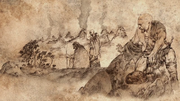
The ancient Valyrians were originally humble shepherds who found dragons nesting in the volcanic mountains around their homeland.
Thought to initially be a modest community of shepherds, the Valyrians rose to prominence five thousand years ago after they discovered dragons living in the Fourteen Fires, a string of volcanoes in the mountains of their homeland. After taming the mighty beasts, the Valyrians used them to conquer surrounding lands of the Valyrian Peninsula, and began expanding outwards.
The Ghiscari Empire, however, sought to halt Valyrian expansion and declared war on their neighbors from the opposite shore of Slaver's Bay. Massive Ghiscari slave-legions marched against Valyria in a series of five major wars, but each time they were defeated. The Freehold's forces then marched on the Ghiscari capital of Ghis and laid waste to it, leaving little more than a smoldering ruin behind and nearly erasing Ghiscari people and culture from history.
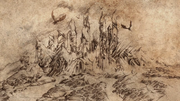
Old Valyria, City of Wonders
Afterward, the Valyrian Freehold became the dominant civilization in the known world, with its own language, religion and customs. The Freehold founded a number of colony cities, connected by a network of roads all of which led back to the capital city. Several of these colonies in the west became the Free Cities. They eventually came into conflict with the Rhoynar city-states along the Rhoyne River, leading to the Rhoynish Wars. The fighting culminated about one thousand years ago in the defeat of the Rhoynar and destruction of their cities, with the survivors fleeing in a mass migration led by Nymeria, whose refugee fleet eventually settled in Dorne in southeastern Westeros.

Due to generations of inbreeding, the Targaryens retained distinctly Valyrian features: a pale complexion and white (platinum blonde) hair.
A few centuries ago, one of the great houses of Valyria, House Targaryen established the fortress of Dragonstone off the coast of the continent of Westeros, using it as a trading outpost of the Valyrian Freehold.
The Doom and Aftermath

The Doom of Valyria was a massive volcanic eruption which destroyed the entire Valyrian civilization in a single day.
For nearly five thousand years, Valyrian supremacy remained uncontested. However, a cataclysmic event known as "The Doom" - a massive volcanic eruption of the Fourteen Fires - laid waste to the Valyrian capital, its people, and the surrounding lands. The Valyrian peninsula itself was shattered and the ocean came sweeping in, becoming the Smoking Sea. Dragons, as well as Valyrian recorded history, spells, and knowledge were lost. With its center of power destroyed, the empire collapsed. Of the mighty families of dragonlords who ruled the Freehold, only House Targaryen survived, as it had established Dragonstone far across the Narrow Sea years before the Doom.
The surviving colonies of the Valyrian Freehold split up into rival independent city-states. In the west, they became the Free Cities. In the east, the conquered Ghiscari cities of Slaver's Bay reasserted their independence, but five thousand years of Valyrian domination had swept away most of their original culture.

After Valyria fell, their former empire imploded from civil wars and Dothraki raids, known as the Century of Blood.
With the heartland of the Freehold destroyed, its surviving colonies to the west and east re-asserted their independence, politically fracturing the continent and initiating a series of savage wars for dominance known as the "Century of Blood", during which Volantis attempted to reform the Valyrian empire under their rule, but ultimately failed. Several of these colonies formed into the Free Cities in the west, and the cities of Slaver's Bay in the east. The Valyrian Peninsula itself in the center remained devastated and largely deserted.
Meanwhile, without the Valyrians and their dragons to keep them in check, the Dothraki mounted hordes swept across the continent from the central plains of the Dothraki Sea, plundering and carving out new domains from surrounding areas - from the Dothraki point of view, the Doom started their own golden age of conquest and expansion. In the far northwest of Essos, the hidden city of Braavos, founded by escaped slaves who fled Valyria, now revealed itself to the world. While the other Valyrian colonies were left in chaos, Braavos was an island of stability because it had no political or economic ties with the Freehold, and quickly rose to become the most powerful of the Free Cities.[2]
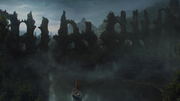
Tyrion and Jorah travel by boat on the Smoking Sea through the towering ruins of old Valyria
The ruins of Valyria in the Smoking Sea remain and are considered to be cursed by other civilizations. Some believe that 'the Doom still rules Valyria', inhabiting it with demons and preventing anyone from ever entering the ruins and emerging alive. In response to the disease known as greyscale, the cities of the east send those most affected by the plague, known as the Stone Men, to the ruins of Valyria to die. The advanced disease means that few, if any, of the Stone Men retain any lucid thought, becoming monstrous creatures who attack any who wander through Valyria.[3][4]
Cities
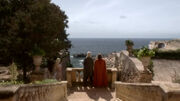
The Valyrian Freehold was vast: in the west, it stretched all the way to its colony city Pentos on the Narrow Sea, northwestern-most of the Free Cities.
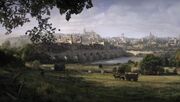
Volantis was the first of the Free Cities founded by the Valyrian Freehold, as well as the southeastern-most.
Ruined cities
Surviving colonies in the Free Cities
Note: Braavos wasn't a Valyrian colony, but a hidden city founded by slaves who escaped from Valyria.
Surviving colonies in the Valyrian Peninsula
Surviving cities in Slaver's Bay
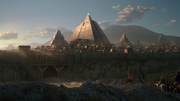
To the east, the Valyrian Freehold stretched all the way to Meereen and beyond. Slaver's Bay was one of Valyria's early conquests.
In the books
In the A Song of Ice and Fire novels, Valyria was neither a kingdom nor an empire: theoretically, all of the freeborn landholders ("free-holders") had equal say in government, hence the formal name of their government was the "Valyrian Freehold". In practice, however, this meant that it was essentially an oligarchy run by the wealthy noble families (there was no single emperor or king). There were about forty great families of wealth, high birth, and strong sorcerous ability, known as Dragonlords, that owned dragons and tended to dominate the rest. The Targaryens were one of these families, but far from the most powerful.
The Freehold not only conquered the Ghiscari Empire, but also the city-states of the Rhoynar people established around the Rhoyne river, leading to their exodus across the sea to Dorne. The modern Free Cities, as well as several others, were established as Valyrian colonies and became independent after the empire was shattered. The major exception to this is Braavos, located in the extreme northwest of Essos, which was founded by escaped slaves who fled Valyria, and remained hidden even long after the Doom. Braavos is thus sometimes referred to as the Bastard Son of Valyria.
The Freehold had a strict policy of religious toleration: anyone in the empire, from dragonlord to slave, was free to practice whatever religion they chose and believe what they wanted to believe, provided they did their work and paid their taxes. In fact, some of the Free Cities were founded by religious dissidents who found the Valyrians' too' tolerant. This was basic good governance on the Valyrians' part, and also a means of keeping their large slave population relatively under control. The Valyrians themselves had their own gods, but the maesters suspect that the dragonlords were so arrogant that they considered themselves above any religious affiliation, including their own.
Real-life connection
George R.R. has stated that the Valyrian Freehold is his world’s version of the Roman Empire, and there are many similarities between the two:
Origins
- Both originated in a peninsular area on the southern edge of their respective continents
- Their founders came from humble origins (Rome began as a small settlement, and the Valyrians began as shepherds)
Territorial expansion
- From their homelands, each gradually expanded to include much of the “known world”
- On a map, the area within the Freehold’s borders is similar in shape to the Roman Empire’s lands north of the Mediterranean Sea
- The various regions/provinces were linked by an elaborate and sophisticated system of roads
Culture/Legacy
- Technological superiority and military discipline allowed both to have an edge over their adversaries
- Both were beacons of “civilization” in their time and still considered an ideal of such after their falls
- The loss of authority/central leadership caused their outlying lands to break away and begin warring against each other for regional power
- Their languages (Latin and High Valyrian) became the “lingua franca” in many lands they once controlled and beyond, but in time fell out of common use
See also
References
- ↑ "The Free Cities (Histories & Lore)"
- ↑ "The Free Cities (Histories & Lore)"
- ↑ "Sons of the Harpy"
- ↑ "Kill the Boy"
